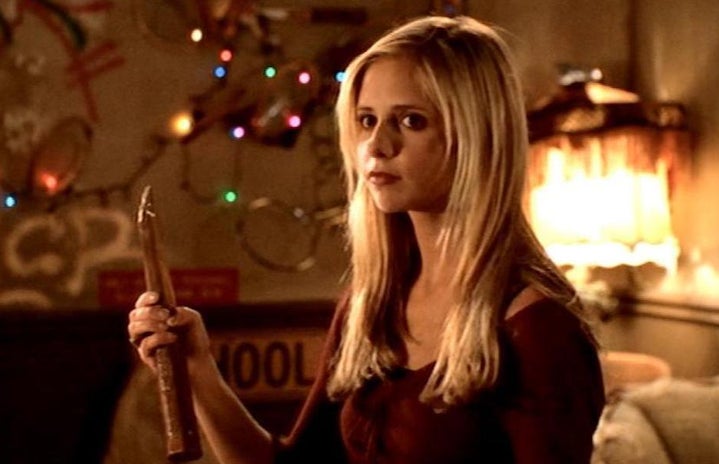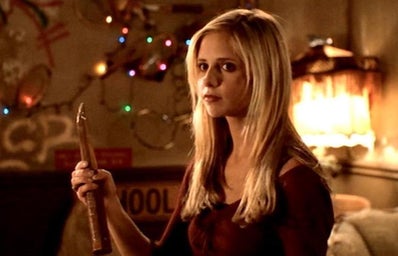While sitting in my Chemistry tutorial, I was approached by a peer regarding my laptop wallpaper – a picture of Willow Rosenberg and Tara Maclay from an old television series called Buffy the Vampire Slayer. I know as a teenage girl, you ultimately strive to find something which cannot only provide a personal glimpse into your own life, but something you can also take comfort in. A movie which always makes you emotional, or a song that you always listen to that puts you in a happier mood. Therefore, here is my personal campaign advocating that everyone should watch Buffy the Vampire Slayer as not only does it encompass all these things, but so much more.
Buffy the Vampire Slayer was released in 1997, and like most TV shows from the 90s, episode one starts off with an extremely cheesy monologue. The episode dives into the life of Buffy Summers, a 15-year-old student who must switch schools as per an incident at her old Los Angeles high school. What I thoroughly enjoy about episode one is Buffy’s denial about her identity as the slayer. Though the show is appropriately named after her, Buffy never really identifies with her title as the slayer, as she knows it’s a signalling trait that she is immensely different from her peers and continuously lives with the burden of saving mankind…when she is literally just a teenage girl.
Buffy the Vampire Slayer can resonate with many young girls as the show is quite literally a metaphor of growing up, especially expanding on that transition from adolescence to adulthood. Starting when she is 15 and ending when she hits the age of 22, the show touches upon so many different subjects that are milestones in not only her life, but also the characters around her.
If the apocalypse comes, beep me.
Never Kill a Boy on the First Date (S1E0) Buffy the Vampire Slayer (1997)
One major topic that struck out to me was probably the introduction of one of the first positively represented LGBTQ+ couples in popular television. Though series such as Queer as Folk and Will and Grace were also airing at the time, these shows were geared towards older individuals, post AIDs epidemic, and primarily focused on the representation of gay men. However, Buffy the Vampire Slayer grew up with teenagers and was meant to be watched by teenagers. During season four, one of the secondary characters within the show, Willow Rosenberg, experiences a major shift in how she ultimately views her identity and sexuality. She meets Tara Maclay, a freshman at UC Sunnydale, post-breakup with her high school boyfriend, Oz. Unlike many TV shows written with a male-gaze, Buffy the Vampire Slayer did not sexualize Willow or make the relationship to be an experimental fling, but slowly incorporated it to eventually become a serious relationship. Being one of the first female queer relationships in mainstream television, it was a major step for the LGBTQ+ community, as it depicted queer relationships to be normal and ‘non-sinister’.
Ever since the introduction of the ‘Hays Code’ in the mid-20th century, media and directors in the television industry have been scared to chronicle the lives of queer characters, because if they were to be represented, they must either be evil or have an untimely demise due to the immorality of their nature. Though abolished, it still haunts the entertainment industry through the ‘Bury Your Gays’ trope, which is common in most television series [SPOILERS], such as The 100, Supernatural, and The Vampire Diaries. Though this may have also occurred in Buffy the Vampire Slayer, being one of the first series to even expand on a healthy, but human women-loving-women (wlw) relationship, it was sadly inevitable. The show is one of the legitimate blueprints of a healthy and cooperative relationship and had been a martyr for future instances of these relationships in television [END OF SPOILERS].
With topics of growth and individualism appearing during each episode, normal things, such as first love, heartbreak, familial conflict, and even death due to natural causes, makes the show transition from simply being your normal science-function or action TV show, to also being quite relatable.
Buffy Summers isn’t a butch, not-like-other-girls protagonist, but instead a protagonist who desires to be considered normal in the perception of her peers. This in turn, results in a superheroine who maintains the balance between her femininity and power as a ‘vampire slayer’. Her ability to normalize taboo topics while also fighting supreme evil, kind of makes her badass.
Hopefully, this convinced you enough to watch the first episode ‘Welcome to the Hellmouth’ – I know I just might after writing this.


